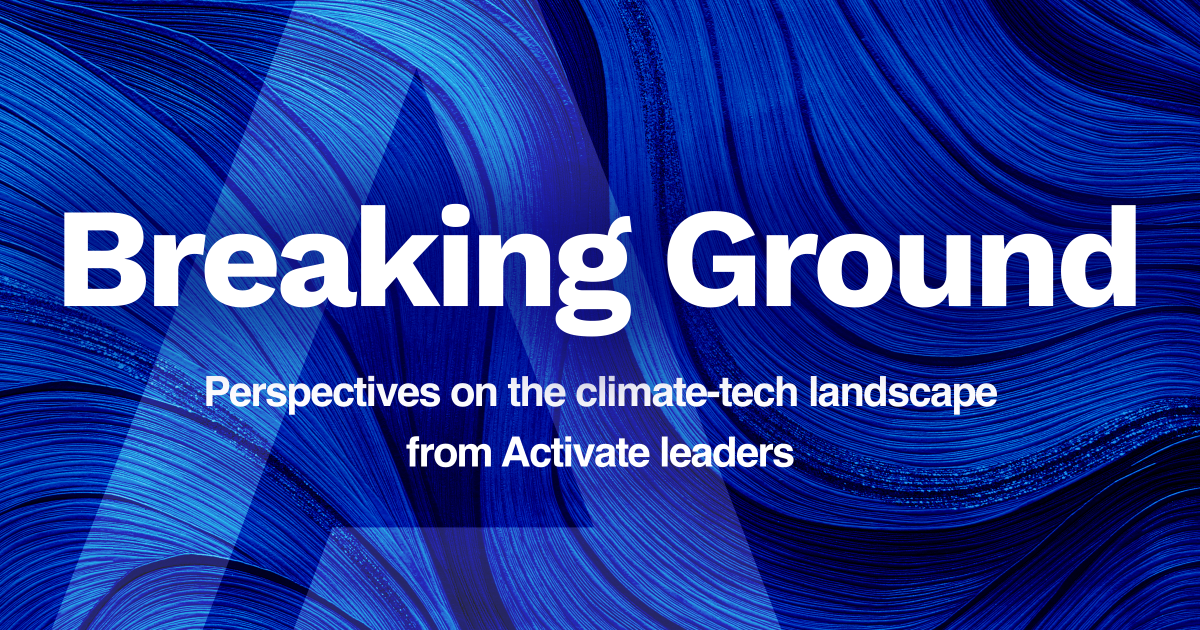Breaking Ground: Don’t give up on climate philanthropy
August 23, 2024
By Karin Lion, Activate Chief Growth Officer


Karin Lion
Activate Chief Growth Officer
In a past life, I worked at a major philanthropic foundation, where I was responsible for allocating nearly $150M of grant funding across a variety of sectors. As a donor, you understand that one single investment isn’t going to change the world, but you do hope the portfolio of investments you make will have a ripple effect. So with this in mind, you try to assess the return on each investment you make as best as you possibly can.
The real problem, of course, is that evaluating impact in the social sector is challenging at best. There’s no uniform industry barometer for impact. Social impact, in particular, can be squishy, with many contributing factors to the ultimate outcome, and it’s often hard to be confident that your (charitable) investment is the best bang for your buck. Personally, these facts weighed on me in this previous life of mine, and I didn’t always feel as confident as I would have hoped in my investments.
Since joining Activate, I’ve learned that our fellowship can give philanthropists assurance that their support will make a difference.
Every dollar directly invested in an Activate Fellow brings in 38 more dollars for the cause. How do we know this? As of August 2024, Activate Fellows have collectively raised over $2.4B in follow-on funding, which is a remarkable 38X leverage of each dollar Activate has invested in them (in the form of their living stipend, R&D grant, health insurance, and professional development stipend).
“There’s no uniform industry barometer for impact.... and it’s often hard to be confident that your (charitable) investment is the best bang for your buck. ”
In all my years in philanthropy, I had never seen such a clear and compelling ROI as this. The strong validation from government, venture capital, and industry highlights the market demand for hard technologies that are addressing massive global challenges like climate change.
We are in a critical time for climate tech. Many of the technologies we need are still at the prototype stage, and now is the time to invest in commercialization to get them out into the market and in a position to scale. There is an enormous gap in terms of getting these solutions from “zero to one”—meaning scientists and engineers need significant hands-on support to take that first leap out of the lab and bridge what is commonly known as the first “valley of startup death.” In order to scale, climate-tech startups need to survive their pivotal first two years when the risk of failure is at its highest and available funding is at its lowest. This is where Activate comes in.
Working with academia, government, corporations, investors, and philanthropy, we bridge the science-to-market gap—while taking no equity in fellow companies. This means we have no vested interest and can provide support and guidance without bias. Activate and partners like Elemental Excelerator, Third Derivative, the Engine Accelerator, Prime Coalition, Breakthrough Energy Fellows, and Greentown Labs form a crucial and ever-growing early-stage innovation system. The stronger this ecosystem is, and the more support this ecosystem receives, the more climate technologies have a chance at achieving impact at scale. Supporting scientists at the earliest stages is proving to be crucial.
“In all my years in philanthropy, I had never seen such a clear and compelling ROI as this. ”
With all this said, it’s worth mentioning that climate philanthropy is experiencing a moment of uncertainty. After years of growth, philanthropic funding to mitigate climate change remained flat in 2022 and philanthropic giving overall dropped off in 2023, mostly due to inflation. But, some venture capitalists are confident that now is still the right time to invest in early-stage climate tech because today’s diverse capital stack enables pathways to commercialization that have never existed before. Not only is climate tech more crucial than ever—the chances of success are also better than ever before.
“We bridge the science-to-market gap—while taking no equity in fellow companies. ”
The multiple examples of Activate Fellows breaking records and launching first-of-their-kind technologies are further evidence of why we at Activate are still optimistic about the future. For example, Fervo Energy (Tim Latimer and Jack Norbeck, Cohort 2018) is leveraging geothermal for the first time to produce carbon-free electricity to power Google’s data centers in Nevada. And Antora Energy (David Bierman, Cohort 2017, Justin Briggs and Andrew Ponec, Cohort 2018) invented a battery with the highest temperature ever recorded for a full-scale thermal battery and is the only energy system in the world that can cost-effectively produce both zero-emissions heat and zero-emissions power. These companies would not exist without the Activate Fellowship. We are committed to raising more philanthropic and government funding to support even more scientists and engineers around the United States with the potential for enormous impact.
“Not only is climate tech more crucial than ever—the chances of success are also better than ever before. ”
If you’re in climate philanthropy and wondering where to invest to commercialize and scale up solutions, Activate and our partners can help you identify the highest-impact opportunities.
While there are no guarantees in any philanthropic investment, I can just personally say that if I had that $150M of grant funding again, I’d feel pretty darn good about investing it in the Activate Fellowship.
